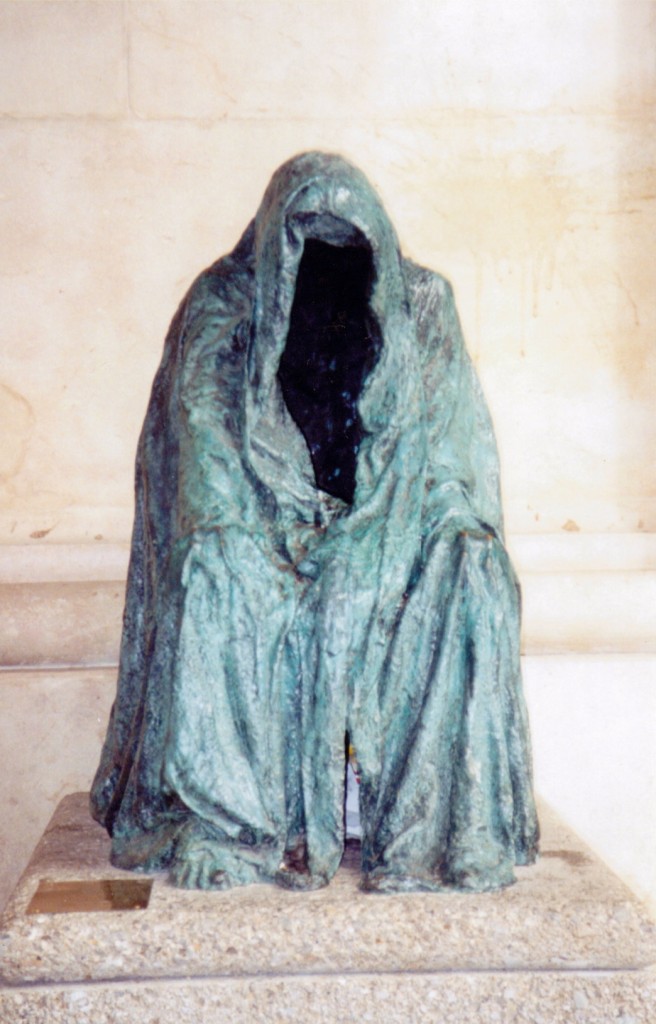Matthew O’Neil, writing on Dan Arel’s Danthropology blog over on the Atheist Channel, has written what he considers to be a scathing indictment of Pope Francis which he titles “Pope Francis fails to lead a Christian life.” “[T]he person who leads the Catholic faith,” O’Neil writes,
“…does little to actually support the destitute, and, instead, redistributes the wealth within the empire of Catholicism. All the while using small measures to save face.”
O’Neil regards the Pope’s symbolic gestures as so much window dressing. He cites, then immediately dismisses examples of the Holy Father’s personal largesse: his inviting four homeless men and their dog to dine with him at the Casa Santa Marta, or his installation of three showers for the convenience of the poor of Rome, or his distribution of 400 sleeping bags. Merely for show, O’Neil says; a drop in the bucket, considering the Vatican’s vast wealth. He writes:
Especially after the slight few instances where Francis has barely even scratched the surface with being generous, especially with the means that the Vatican has, it is downright disgusting for him to even make such remarks as he has about helping the poor.
Like Sarah Silverman stated, we should consider selling the Vatican to help feed the world. If for no other reason other than it would have been what Jesus would have wanted.
Overlooking the fact that O’Neil draws his perspective from the rants of atheist stand-up comedian Sarah Silverman, I would like to counter some of his criticisms with facts. For one thing, the Catholic Church is a world-wide institution which is not owned and operated by a single individual. It’s difficult to quantify its charitable giving. Nonetheless, it is the largest funder of charitable projects in the world. Don’t believe me? Listen, instead, to Slate quote a study by the Economist:
Our best window into the overall financial picture of American Catholicism comes from a 2012 investigation by the Economist, which offered a rough-and-ready estimate of $170 billion in annual spending, of which almost $150 billion is associated with church-affiliated hospitals and institutions of higher education. The operating budget for ordinary parishes, at around $11 billion a year, is a relatively small share, and Catholic Charities is a smaller share still.
An older article in Time Magazine notes that the dividends from the Vatican’s financial investments help to pay for some of its charitable endeavors:
Dividends help pay for Vatican expenses and charities such as assisting 1,500,000 children and providing some measure of food and clothing to 7,000,000 needy Italians.
(And this is in 1965 dollars, so that dollar amount would have increased exponentially in the ensuing decades.) And of course, this says nothing about the additional expenditures for programs for the poor and underserved at diocesan level, at parish level, by Catholic nonprofit organizations, and from the pockets of individual churchgoers. Catholic social teaching has always cited what is called a “Preferential Option for the Poor.” Pope Benedict XVI, in his 2009 encyclical “Caritas in Veritate” (“Charity in Truth”), speaks at length about the requirement to help the poor as a matter of justice. He says,
“To desire the common good and strive towards it is a requirement of justice and charity…. The more we strive to secure a common good corresponding to the real needs of our neighbours, the more effectively we love them. Every Christian is called to practise this charity, in a manner corresponding to his vocation and according to the degree of influence he wields in the [state]. This is the institutional path–we might also call it the political path–of charity, no less excellent and effective than the kind of charity which encounters the neighbor directly…”
The U.S. Conference of Catholic Bishops has prepared an extensive aid regarding Church teachings on poverty. Included are links to the Compendium of Social Doctrine of the Church, the guide to Informing Consciences for Faithful Citizenship, the 2002 A Place at the Table: A Catholic Recommitment to Overcome Poverty and to Respect the Dignity of All God’s Children, the USCCB’s 2005 Statement Seven Themes of Catholic Social Teaching, Pope Benedict’s 2005 encyclical Deus Caritas Est (God Is Love), and much more.
I invite Matthew O’Neil and Dan Arel, if they really want to research Catholic giving, to learn about that of which they speak. Pope Francis’ generosity is a demonstration project of how we are to live in loving outreach to our homeless brethren. It is a tangible example of charity; but is hardly the only charity which the Church exercises in her daily ministry.
My point is this: Matthew O’Neil has zero cred when it comes to talking about how the Church spends its money. He doesn’t understand his subject. There are other reasons, though, to reconsider the tired old “Sell St. Peter’s” meme. I’ve written on it once before, and have appended that post here. First, though, an image from my travels in Austria: At the Cathedral of St. Rupert and St. Virgilius in Salzburg, Austria, I snapped this photo:  This wonderful brass sculpture stands beside the Cathedral. It’s “empty”–there’s a tunic and veil, but there’s no face staring out from the folds. It represents the “invisible poor.”
This wonderful brass sculpture stands beside the Cathedral. It’s “empty”–there’s a tunic and veil, but there’s no face staring out from the folds. It represents the “invisible poor.”
* * * * *
My earlier post, which seems to carry this discussion in a new but still relevant direction, was written after an encounter on an Amtrak train en route from Chicago to Detroit. I’d met a man named Mark, who raised important questions regarding the Church’s wealth and her charity.
Mark described himself as a Christian but not a Catholic. As Amtrak #358 sped along the track from Chicago, where I’d been attending a conference, to Dearborn, Mark and I chatted about a lot of things: about our families, about our work, and about faith. When he heard that I was a Catholic writer, he embraced the opportunity to raise a few questions about Pope Francis and to express some concerns that he had with the Church, as he understood it.
Talking about his travels to Rome, Mark said of St. Peter’s Basilica:
“I looked up at the great basilica, and I had two reactions: First, I appreciated its beauty and reverence; but then I thought, ‘What corruption caused someone to spend so much on this building when people are hungry’?”

I know that Mark’s questions are echoed by many others who see the Church from the outside, but who have never talked to a real Catholic to get an insider’s perspective.
Mark had a good point: Certainly there are widows and orphans to feed, refugees to house, expectant mothers to assist and abandoned spouses to comfort. Mindful of all of these profound needs, shouldn’t the Church divest itself of its great wealth and give it all to the poor?
I’d like to suggest four key reasons why selling all is NOT the approach mandated by the Scriptures.
1. Gratitude Requires That We Preserve the Gifts of Those Who Have Gone Before Us.
Wouldn’t you seem ungrateful if your parents had scrimped and saved to give you a pricey wedding gift, only to have you cast it aside? Likewise, past generations of the faithful–grateful for God’s beneficent care, and eager to share their appreciation by giving of their blessings–have donated the funds, or contributed the artwork, or supported the artist, with the expectation that their gift will be appreciated and will serve as an inspiration to prayer for future generations.
2. Jesus himself expected that we would honor him with our wealth.
Remember the story in Luke 12, when the woman washes Jesus’ feet with her hair, and anoints them with expensive nard? It’s Judas who objects–insisting that the perfume could have been sold, and the money used to feed the poor. But rather than agreeing with Judas, Jesus scolds him–reminding him that the poor, we will always have with us. Here is the story (American Standard Version):
3 Mary therefore took a pound of ointment of pure nard, very precious, and anointed the feet of Jesus, and wiped his feet with her hair: and the house was filled with the odor of the ointment.
4 But Judas Iscariot, one of his disciples, that should betray him, saith,
5 Why was not this ointment sold for three hundred shillings, and given to the poor?
6 Now this he said, not because he cared for the poor; but because he was a thief, and having the bag took away what was put therein.
7 Jesus therefore said, Suffer her to keep it against the day of my burying.
8 For the poor ye have always with you; but me ye have not always.
Jesus was God, and was worthy of devotion. Even though there were poor people to be served, it was fitting that he should have been honored by her anointing with the precious oil. In the same way, it is right and good to build something (or paint something, or sculpt something) truly beautiful for God.
3. The Poor Deserve Beauty, Too.
If the great art of the Church were sold, it would most likely be preserved behind closed doors, in private collections of the very wealthy. Better, I think, to allow everyone–even persons of humble means–to enjoy the works of the Masters, to allow their hearts and minds to be drawn upward toward heaven by the rich imagery of the saints, by the glow of alabaster and the sheen of marble and the intricacy of fine metalwork. The Church has been a repository of great art, and has made its treasures available for all to enjoy.
4. Beauty Leads Us to Holiness.
Thomas Aquinas named three characteristics of beauty: integritas (integrity), consonantia (proportion), and claritas (clarity). Beauty is something which we recognize in creation, and it leads us to greater understanding of God, who in creating the Beautiful has shown us a little of His boundless Beauty. As we appreciate the beauty of a flower, we begin to understand a little more of the beauty of its Creator, and we are drawn to love Him more. Likewise, when a stained glass window enraptures us with its shimmering color and its profound imagery, we appreciate the creator (the artist), and the Creator of the creator (God).











